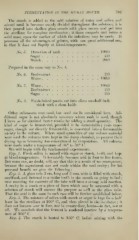Page 783 - My FlipBook
P. 783
: :
FERMENTATION IN THE HUMAN MOUTH. 793
The starch is addetl to the cold sohition of water and saliva and
stirred until it becomes evenly divided throughout the solution ; it is
then poured into shallow glass vessels with glass covers and put into
it there congeals and forms a
the sterilizer for complete sterilization ;
solid mass, upon the surface of which the infections may be made. It
possesses all the advantages of gelatin, with one great additional one,
in that it does not liquify at blood-temperature.
No. 5. Decoction of malt 100.0
Sugar 2.0
Starch 20.0
Prepared in the same way as No. 4.
No. 6. Beef-extract 2.0
Water 100.0
No. 7. Water 100.0
Beef-extract 2.0
Sugar 2.0
No. 8. Fresh-baked potato cut into slices one-half inch
thick with a clean knife.
Other substances were used, but need not be considered here. Ad-
ditional sugar is not absolutely necessary where malt is used, though
I have so far obtained better results by adding a small quantity. The
kind of sugar is immaterial, provided it be fermentable ; even cane-
sugar, though not directly fermentable, is converted into a fermentable
variety in the culture. Where small quantities of any culture material
were used the cultures were kept in the damp chamber, to prevent their
drying up or becoming too concentrated by evaporation. All cultures
were made under a temperature of 36° to 38° C.
We will begin with the fundamental experiments.
Exp. 1. Fresh saliva is mixed with sugar or starch, 1-40, and kept
at blood-temperature. It invariably becomes acid in four to five hours.
But some one, no doubt, will, say that this is a result of no consequence,
because the experiment was not made within the oral cavity ; for his
personal benefit we give the following
Exp. '3. A glass tube 2 cm. long and 3 mm. wide is filled with starch,
sterilized, and fastened to a molar tooth in the mouth on soina; to bed
next morning the contents of the tube will have a strong acid reaction.
A cavity in a tooth or a piece of linen which may be saturated ^vith a
solution of starch will answer the purpose as well as the glass tube.
That the acid is the same in each case will be further established below.
Exp. 3. The mixture of saliva with starch or sugar is kept for a half
hour in the sterilizer at 100° C, and then placed in the incubator ; it
does not become sour in four, nor in twenty-foiu^, hours—in fact, not at
all. We conclude that the ferment is rendered inactive by a tempera-
ture of 100° C.
Exp. 4- The starch is heated to 150° C. before mixing with the
FERMENTATION IN THE HUMAN MOUTH. 793
The starch is addetl to the cold sohition of water and saliva and
stirred until it becomes evenly divided throughout the solution ; it is
then poured into shallow glass vessels with glass covers and put into
it there congeals and forms a
the sterilizer for complete sterilization ;
solid mass, upon the surface of which the infections may be made. It
possesses all the advantages of gelatin, with one great additional one,
in that it does not liquify at blood-temperature.
No. 5. Decoction of malt 100.0
Sugar 2.0
Starch 20.0
Prepared in the same way as No. 4.
No. 6. Beef-extract 2.0
Water 100.0
No. 7. Water 100.0
Beef-extract 2.0
Sugar 2.0
No. 8. Fresh-baked potato cut into slices one-half inch
thick with a clean knife.
Other substances were used, but need not be considered here. Ad-
ditional sugar is not absolutely necessary where malt is used, though
I have so far obtained better results by adding a small quantity. The
kind of sugar is immaterial, provided it be fermentable ; even cane-
sugar, though not directly fermentable, is converted into a fermentable
variety in the culture. Where small quantities of any culture material
were used the cultures were kept in the damp chamber, to prevent their
drying up or becoming too concentrated by evaporation. All cultures
were made under a temperature of 36° to 38° C.
We will begin with the fundamental experiments.
Exp. 1. Fresh saliva is mixed with sugar or starch, 1-40, and kept
at blood-temperature. It invariably becomes acid in four to five hours.
But some one, no doubt, will, say that this is a result of no consequence,
because the experiment was not made within the oral cavity ; for his
personal benefit we give the following
Exp. '3. A glass tube 2 cm. long and 3 mm. wide is filled with starch,
sterilized, and fastened to a molar tooth in the mouth on soina; to bed
next morning the contents of the tube will have a strong acid reaction.
A cavity in a tooth or a piece of linen which may be saturated ^vith a
solution of starch will answer the purpose as well as the glass tube.
That the acid is the same in each case will be further established below.
Exp. 3. The mixture of saliva with starch or sugar is kept for a half
hour in the sterilizer at 100° C, and then placed in the incubator ; it
does not become sour in four, nor in twenty-foiu^, hours—in fact, not at
all. We conclude that the ferment is rendered inactive by a tempera-
ture of 100° C.
Exp. 4- The starch is heated to 150° C. before mixing with the


